tow Lexus GS350 2016 Owner's Manual
[x] Cancel search | Manufacturer: LEXUS, Model Year: 2016, Model line: GS350, Model: Lexus GS350 2016Pages: 624, PDF Size: 15.29 MB
Page 3 of 624
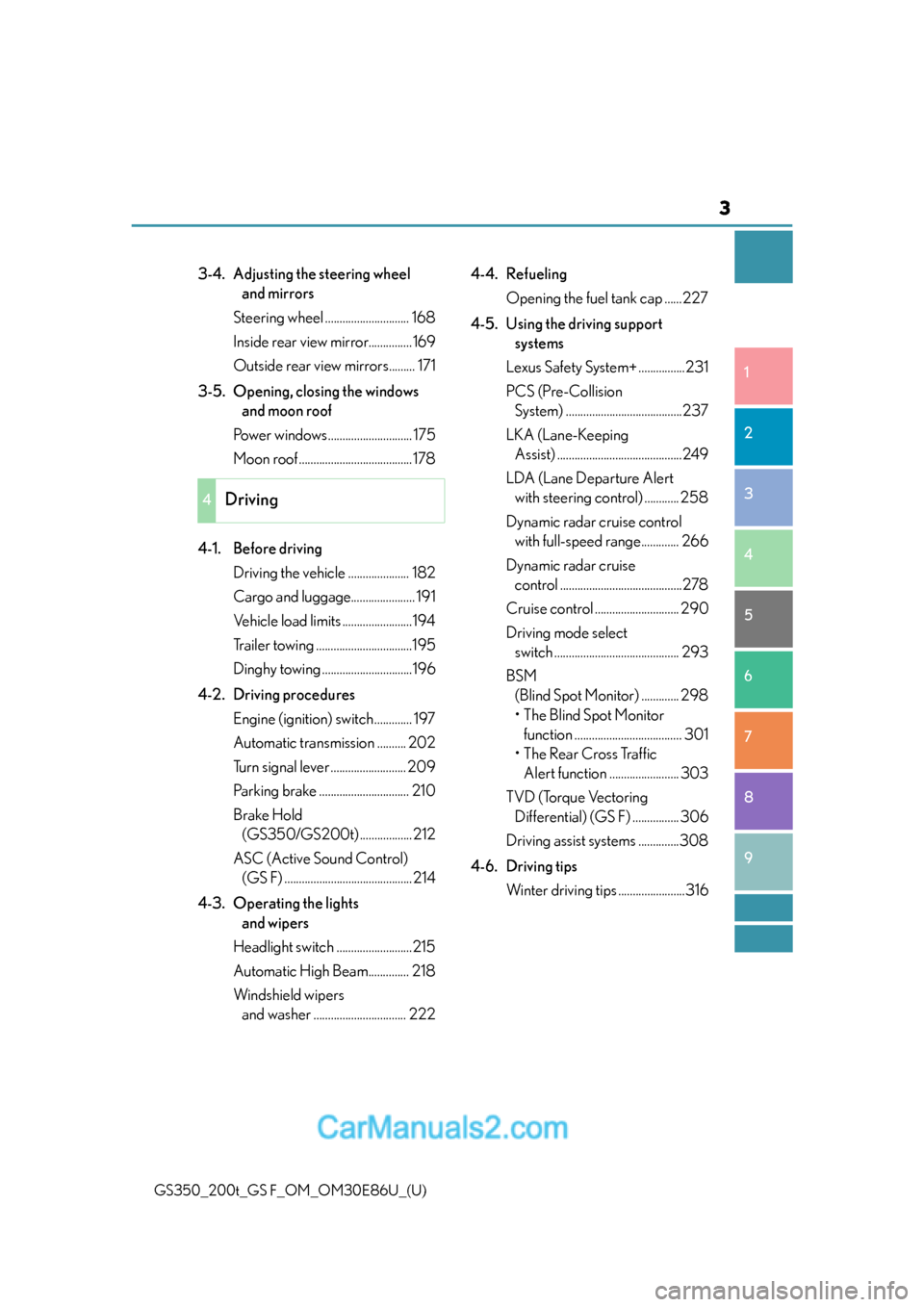
3
1
8 7
6
5
4
3
2
GS350_200t_GS F_OM_OM30E86U_(U)
9
3-4. Adjusting the steering wheel and mirrors
Steering wheel ............................. 168
Inside rear view mirror...............169
Outside rear view mirrors......... 171
3-5. Opening, closing the windows and moon roof
Power windows ............................. 175
Moon roof ....................................... 178
4-1. Before driving Driving the vehicle ..................... 182
Cargo and luggage...................... 191
Vehicle load limits ........................194
Trailer towing .................................195
Dinghy towing ...............................196
4-2. Driving procedures Engine (ign ition) switch ............. 197
Automatic transmission .......... 202
Turn signal lever .......................... 209
Parking brake ............................... 210
Brake Hold (GS350/GS200t) ..................212
ASC (Active Sound Control) (GS F) ............................................214
4-3. Operating the lights and wipers
Headlight switch ..........................215
Automatic High Beam.............. 218
Windshield wipers and washer ................................ 222 4-4. Refueling
Opening the fuel tank cap ......227
4-5. Using the driving support systems
Lexus Safety System+ ................231
PCS (Pre-Collision System) ........................................237
LKA (Lane-Keeping Assist) ...........................................249
LDA (Lane Departure Alert with steering co ntrol) ............ 258
Dynamic radar cruise control with full-speed range............. 266
Dynamic radar cruise control ..........................................278
Cruise control ............................. 290
Driving mode select switch ........................................... 293
BSM (Blind Spot Monitor) ............. 298
• The Blind Spot Monitor function ..................................... 301
• The Rear Cross Traffic
Alert function ........................ 303
TVD (Torque Vectoring Differential) (GS F) ................ 306
Driving assist systems ..............308
4-6. Driving tips Winter driving tips .......................316
4Driving
Page 5 of 624
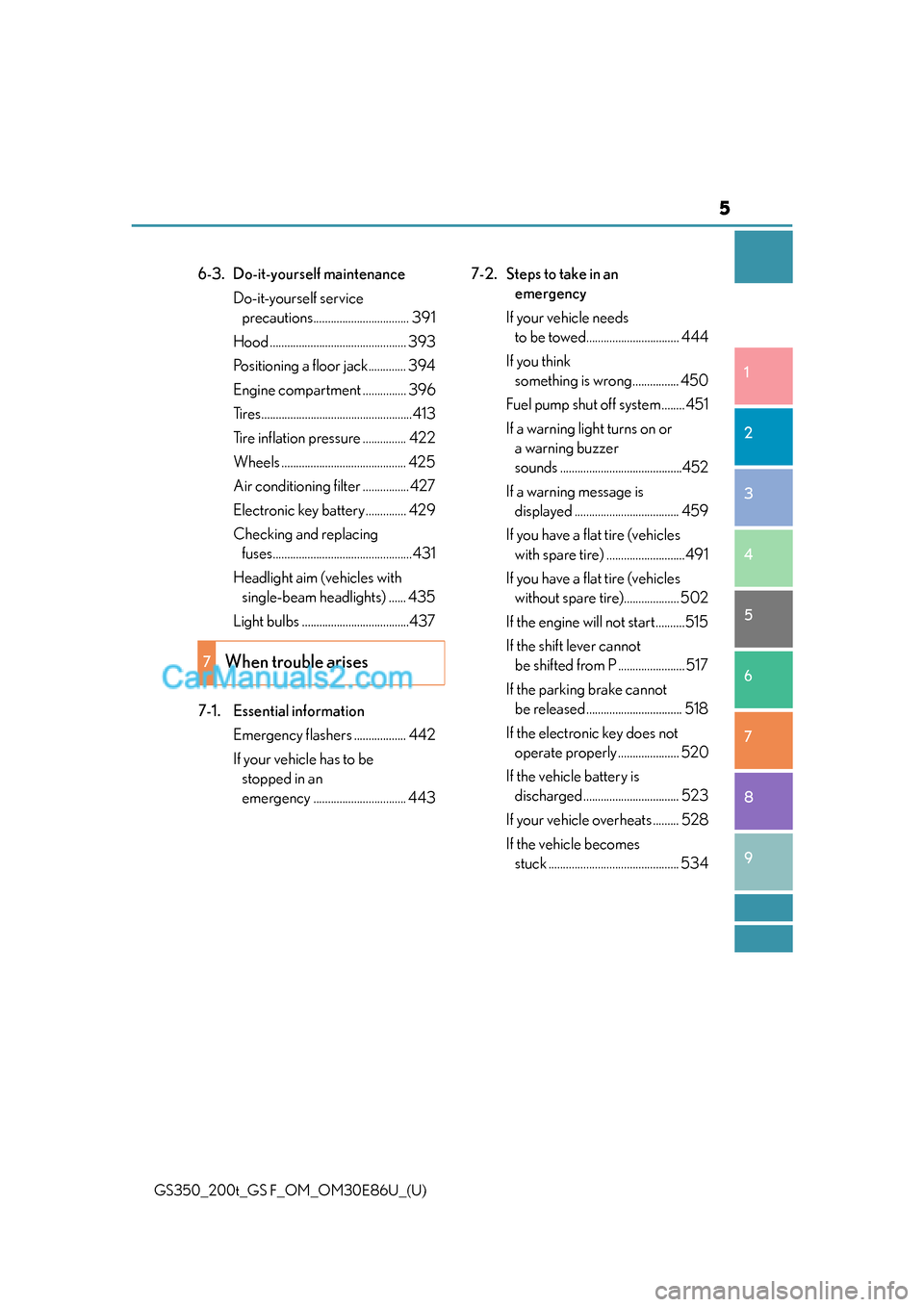
5
1
8 7
6
5
4
3
2
GS350_200t_GS F_OM_OM30E86U_(U)
9
6-3. Do-it-yourself maintenance Do-it-yourself service precautions................................. 391
Hood ............................................... 393
Positioning a floor jack............. 394
Engine compartment ............... 396
Tires....................................................413
Tire inflation pressure ............... 422
Wheels ........................................... 425
Air conditioning filter ................427
Electronic key battery.............. 429
Checking and replacing fuses................................................431
Headlight aim (vehicles with single-beam headlights) ...... 435
Light bulbs .....................................437
7-1. Essential information Emergency flashers .................. 442
If your vehicle has to be stopped in an
emergency ................................ 443 7-2. Steps to take in an
emergency
If your vehicle needs to be towed................................ 444
If you think something is wrong ................ 450
Fuel pump shut off system ........ 451
If a warning light turns on or a warning buzzer
sounds ..........................................452
If a warning message is displayed .................................... 459
If you have a flat tire (vehicles with spare tire) ...........................491
If you have a flat tire (vehicles without spare tire)................... 502
If the engine will not start ..........515
If the shift lever cannot be shifted from P ....................... 517
If the parking brake cannot be released ................................. 518
If the electronic key does not operate properly ..................... 520
If the vehicle battery is discharged ................................. 523
If your vehicle overheats ......... 528
If the vehicle becomes stuck ............................................. 534
7When trouble arises
Page 18 of 624

18Pictorial index
GS350_200t_GS F_OM_OM30E86U_(U)
■Instrument panel
Engine switch . . . . . . . . . . . . . . . . . . . . . . . . . . . . . . . . . . . . . . . . . . . . . . . . . . . . . . . . . P. 1 9 7
Starting the engine/changing the modes . . . . . . . . . . . . . . . . . . . . . . . . . . . . . . . . P. 197
Emergency stop of the engine . . . . . . . . . . . . . . . . . . . . . . . . . . . . . . . . . . . . . . . . . .P. 443
When the engine will not start . . . . . . . . . . . . . . . . . . . . . . . . . . . . . . . . . . . . . . . . . . P. 515
Warning messages . . . . . . . . . . . . . . . . . . . . . . . . . . . . . . . . . . . . . . . . . . . . . . .P. 468, 486
Shift lever . . . . . . . . . . . . . . . . . . . . . . . . . . . . . . . . . . . . . . . . . . . . . . . . . . . . . . . . . . . . P. 202
Changing the shift position . . . . . . . . . . . . . . . . . . . . . . . . . . . . . . . . . . . . . . . . . . . . .P. 202
Precautions against towing . . . . . . . . . . . . . . . . . . . . . . . . . . . . . . . . . . . . . . . . . . . . .P. 444
When the shift lever does not move . . . . . . . . . . . . . . . . . . . . . . . . . . . . . . . . . . . . . P. 517
Meters . . . . . . . . . . . . . . . . . . . . . . . . . . . . . . . . . . . . . . . . . . . . . . . . . . . . . . . . . . . . P. 8 6 , 9 2
Reading the meters/adjusting the instrument panel light . . . . . . . . . . . . . P. 86, 92
Warning lights/indicator lights . . . . . . . . . . . . . . . . . . . . . . . . . . . . . . . . . . . . . . . . . . . P. 78
When the warning lights come on . . . . . . . . . . . . . . . . . . . . . . . . . . . . . . . . . . . . . . P. 452
1
2
3
Page 44 of 624
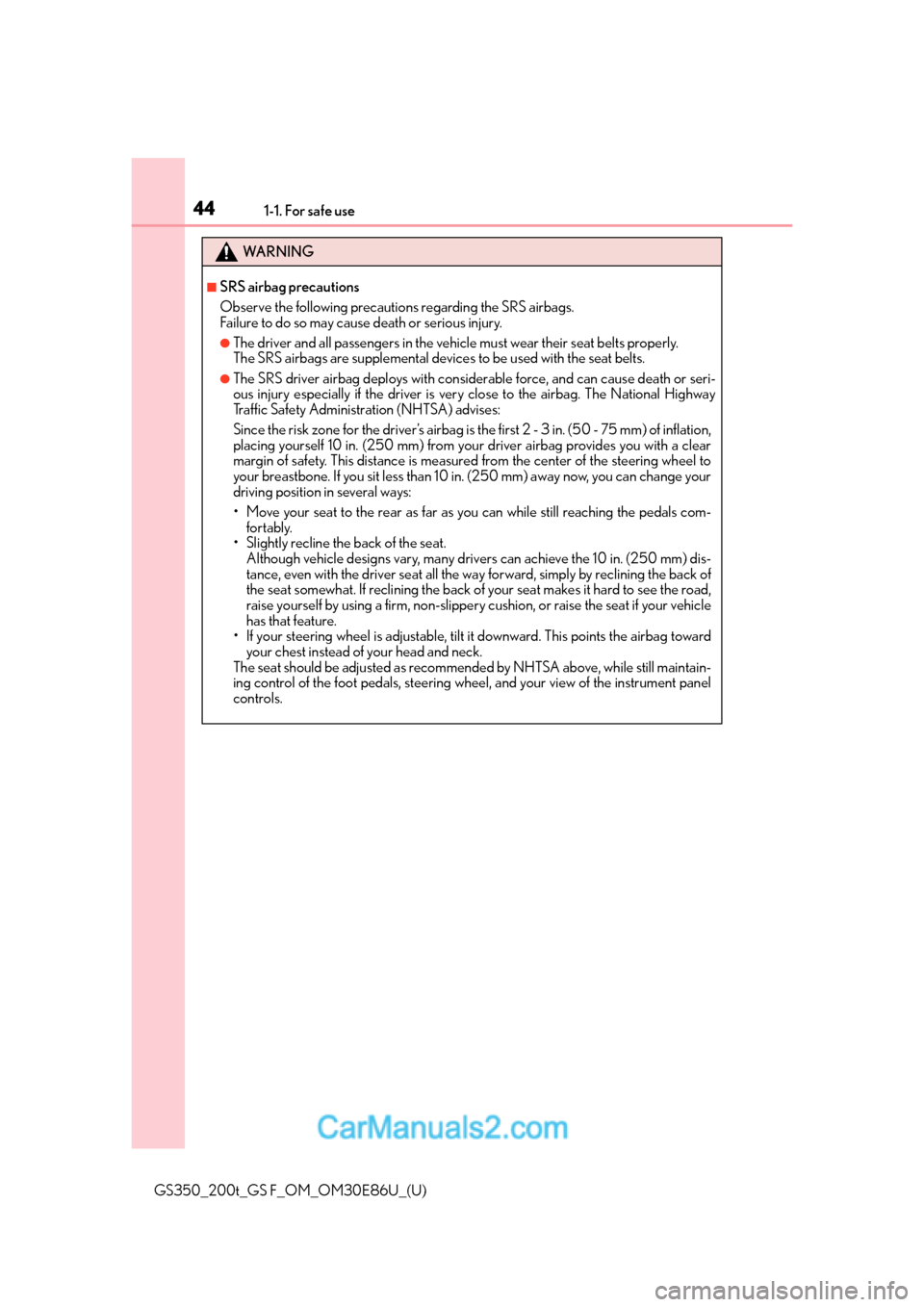
441-1. For safe use
GS350_200t_GS F_OM_OM30E86U_(U)
WA R N I N G
■SRS airbag precautions
Observe the following precautions regarding the SRS airbags.
Failure to do so may cause death or serious injury.
●The driver and all passengers in the vehicle must wear their seat belts properly.
The SRS airbags are supplemental devices to be used with the seat belts.
●The SRS driver airbag deploys with consider able force, and can cause death or seri-
ous injury especially if the driver is very close to the airbag. The National Highway
Traffic Safety Administration (NHTSA) advises:
Since the risk zone for the driver’s airbag is the first 2 - 3 in. (50 - 75 mm) of inflation,
placing yourself 10 in. (250 mm) from your driver airbag provides you with a clear
margin of safety. This distance is measured from the center of the steering wheel to
your breastbone. If you sit less than 10 in. (250 mm) away now, you can change your
driving position in several ways:
• Move your seat to the rear as far as you can while still reaching the pedals com- fortably.
• Slightly recline the back of the seat. Although vehicle designs vary, many drivers can achieve the 10 in. (250 mm) dis-
tance, even with the driver seat all the wa y forward, simply by reclining the back of
the seat somewhat. If reclining the back of your seat makes it hard to see the road,
raise yourself by using a firm, non-slippery cushion, or raise the seat if your vehicle
has that feature.
• If your steering wheel is ad justable, tilt it downward. This points the airbag toward
your chest instead of your head and neck.
The seat should be adjusted as recommen ded by NHTSA above, while still maintain-
ing control of the foot pedals, steering whee l, and your view of the instrument panel
controls.
Page 46 of 624

461-1. For safe use
GS350_200t_GS F_OM_OM30E86U_(U)
WA R N I N G
■SRS airbag precautions
●Do not lean against the door, the roof side rail
or the front, side and rear pillars.
●Do not allow anyone to kneel on the passen-
ger seat toward the door or put their head or
hands outside the vehicle.
●Do not attach anything to or lean anything
against areas such as the dashboard, steering
wheel pad, lower portion of the instrument
panel and door of the glove box.
These items can become projectiles when the
SRS driver, front passenger and knee airbags
deploy.
●Do not attach anything to areas such as a
door, windshield glass, side door glass, front
or rear pillar, roof side rail and assist grip.
(Except for the speed limit sticker P. 5 0 8 )
Page 152 of 624

152
GS350_200t_GS F_OM_OM30E86U_(U)3-2. Opening, closing and
locking the doors and trunk
■Electronic Key Battery-Saving Function
When battery-saving mode is set, battery depletion is minimized by stopping the elec-
tronic key from receiving radio waves.
■Conditions affecting operation
The smart access system with push-button start uses weak radio waves. In the following
situations, the communication between th e electronic key and the vehicle may be
affected, preventing the smart access system with push-button start, wireless remote
control and engine immobilizer system from operating properly.
(Ways of coping: P. 5 2 0 )
●When the electronic key battery is depleted
●Near a TV tower, electric powe r plant, gas station, radio station, large display, airport or
other facility that generates strong radio waves or electrical noise
●When the electronic key is in contact wi th, or is covered by the following metallic
objects
• Cards to which aluminum foil is attached
• Cigarette boxes that have aluminum foil inside
• Metallic wallets or bags
•Coins
•Hand warmers made of metal
• Media such as CDs and DVDs
●When other wireless keys (that emit radio waves) are being used nearby
●When carrying the electronic key together with the following devices that emit radio
waves
• When carrying a portable radio, cellular phone, cordless phone or other wireless
communication device
• Another vehicle’s electronic key or a wireless key that emits radio waves
• Personal computers or personal digital assistants (PDAs)
• Digital audio players
• Portable game systems
●If window tint with a metallic content or me tallic objects are attached to the rear win-
dow
●When the electronic key is placed near a battery charger or electronic devices
Press twice while pressing and holding
. Confirm that the electronic key indica-
tor flashes 4 times.
While the battery-saving mode is set, the smart
access system with push-button start cannot be
used. To cancel the function, press any of the
electronic key buttons.
Page 167 of 624

GS350_200t_GS F_OM_OM30E86U_(U)
1673-3. Adjusting the seats
3
Operation of each component
■Adjusting the height of the head restraints
■Adjusting the rear seat head restraints
Always raise the head restraint one level from the stowed position when using. Make sure that the head restraints are adjusted
so that the center of the head restraint is closest
to the top of your ears.
WA R N I N G
■Head restraint precautions
Observe the following precautions regarding the head restraints. Failure to do so may
result in death or serious injury.
●Use the head restraints designed for each respective seat.
●Adjust the head restraints to the correct position at all times.
●After adjusting the head restraints, push down on them and make sure they are
locked in position.
●Do not drive with the head restraints removed.
Page 168 of 624

1683-4. Adjusting the steering wheel and mirrors
GS350_200t_GS F_OM_OM30E86U_(U)
Steering wheel
Operating the switch moves the steering wheel in the following directions: Up
Down
Toward the driver
Away from the driver
To sound the horn, press on or close to
the mark.
■The steering wheel can be adjusted when
The engine switch is in ACCESSORY or IGNITION ON mode
*.
*: If the driver’s seat belt is fastened, the steering wheel can be adjusted regardless of
engine switch mode.
■Automatic adjustment of the steering position
A desired steering position can be entered to memory and recalled automatically by the
driving position memory system. ( P. 1 6 0 )
■Power easy access system
The steering wheel and driver’s seat move in accordance with engine switch mode and
the driver’s seat belt condition. ( P. 1 6 0 )
Adjustment procedure
1
2
3
4
Horn
WA R N I N G
Do not adjust the steering wheel while driving.
Doing so may cause the driver to mishandle the vehicle and cause an accident, result-
ing in death or serious injury.
Page 173 of 624
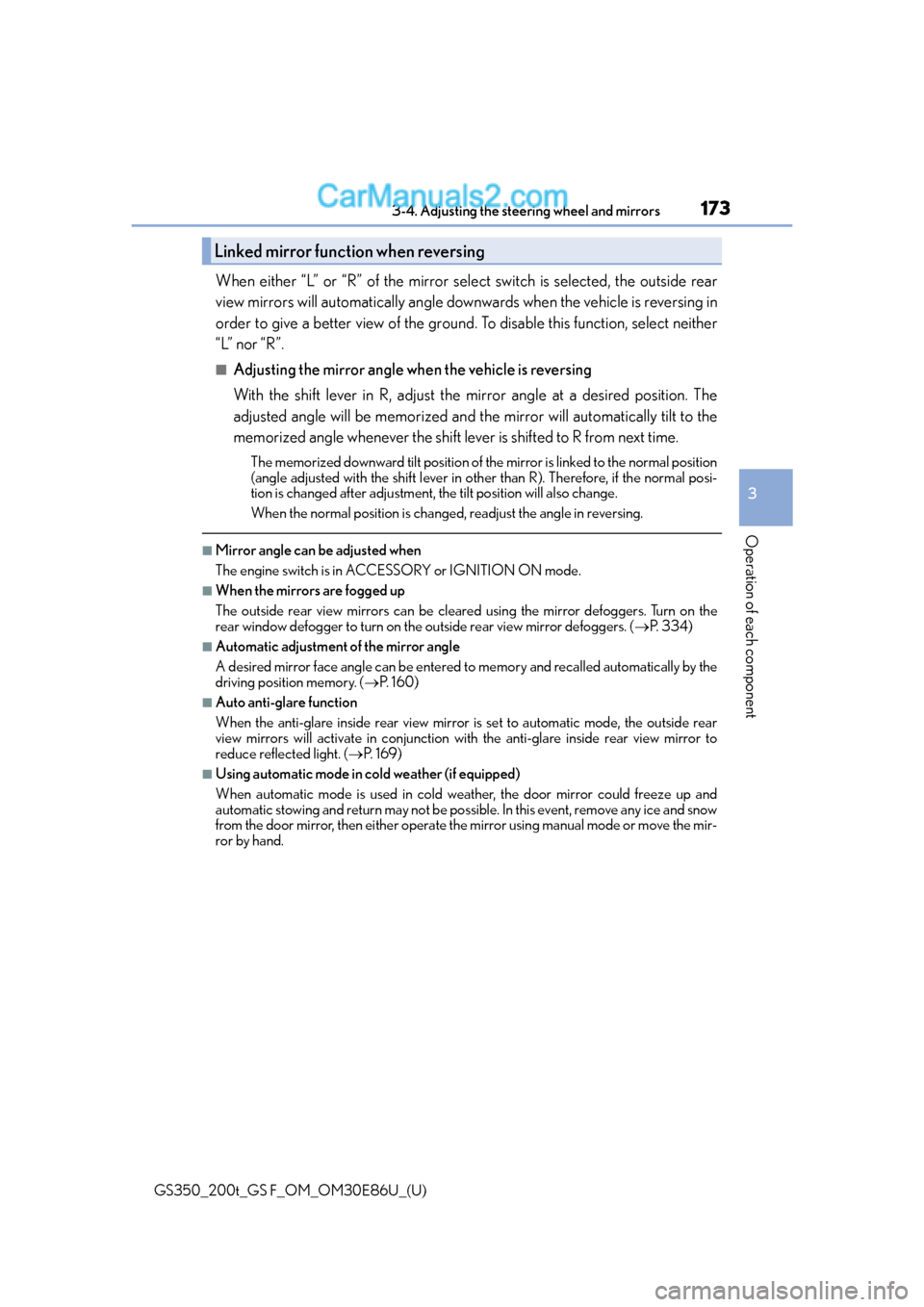
1733-4. Adjusting the steering wheel and mirrors
3
Operation of each component
GS350_200t_GS F_OM_OM30E86U_(U)
When either “L” or “R” of the mirror select switch is selected, the outside rear
view mirrors will automatically angle downwards when the vehicle is reversing in
order to give a better view of the ground. To disable this function, select neither
“L” nor “R”.
■Adjusting the mirror angle when the vehicle is reversing
With the shift lever in R, adjust the mirror angle at a desired position. The
adjusted angle will be memorized and the mirror will automatically tilt to the
memorized angle whenever the shift lever is shifted to R from next time.
The memorized downward tilt position of the mirror is linked to the normal position
(angle adjusted with the shif t lever in other than R). Therefore, if the normal posi-
tion is changed after adjustment, th e tilt position will also change.
When the normal position is chang ed, readjust the angle in reversing.
■Mirror angle can be adjusted when
The engine switch is in ACCESSORY or IGNITION ON mode.
■When the mirrors are fogged up
The outside rear view mirrors can be cleare d using the mirror defoggers. Turn on the
rear window defogger to turn on the outside rear view mirror defoggers. ( P. 3 3 4 )
■Automatic adjustment of the mirror angle
A desired mirror face angle can be entered to memory and recalled automatically by the
driving position memory. ( P. 1 6 0 )
■Auto anti-glare function
When the anti-glare inside rear view mirror is set to automatic mode, the outside rear
view mirrors will activate in conjunction with the anti-glare inside rear view mirror to
reduce reflected light. ( P. 1 6 9 )
■Using automatic mode in cold weather (if equipped)
When automatic mode is used in cold weather, the door mirror could freeze up and
automatic stowing and return may not be possib le. In this event, remove any ice and snow
from the door mirror, then either operate th e mirror using manual mode or move the mir-
ror by hand.
Linked mirror function when reversing
Page 181 of 624
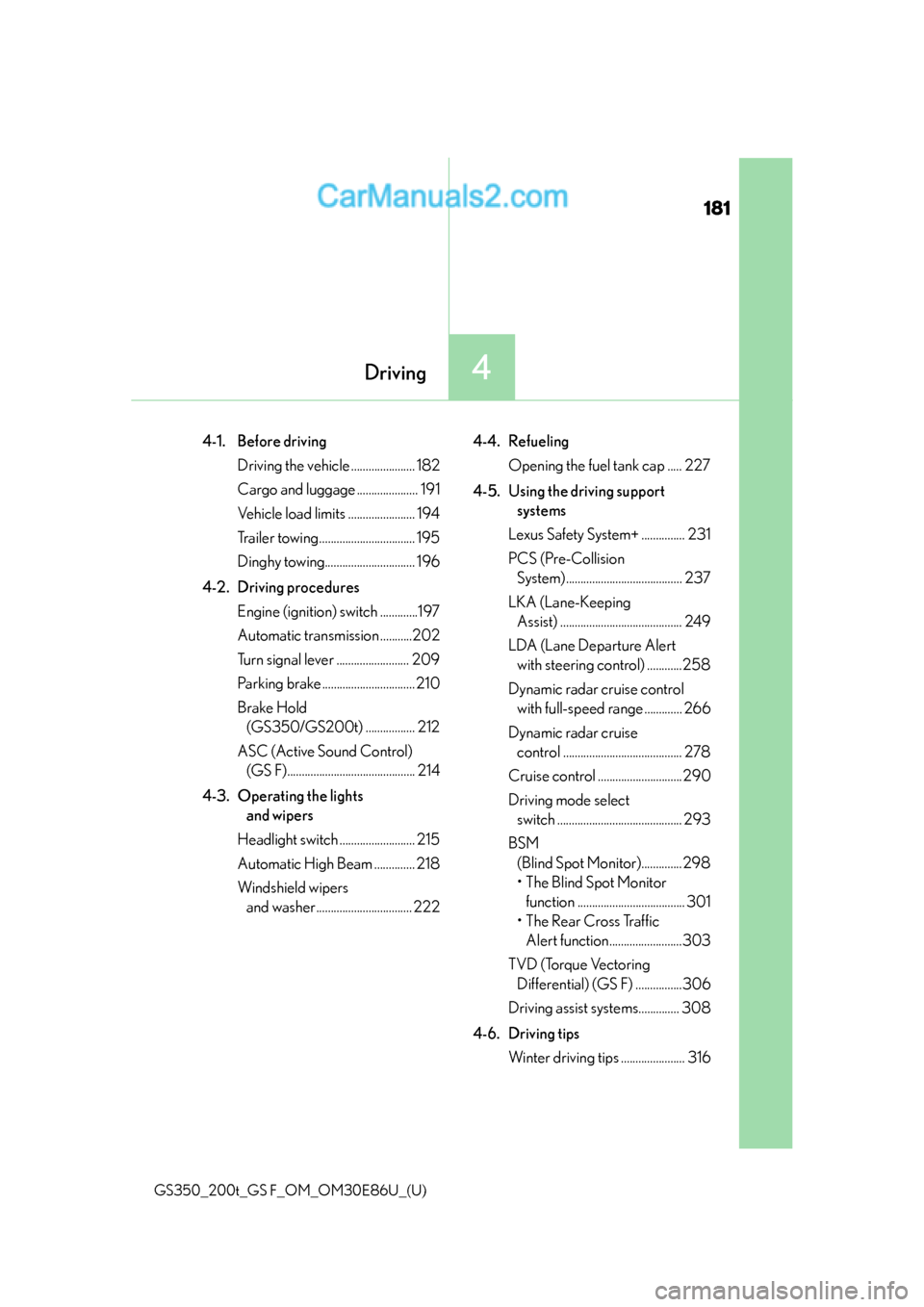
181
GS350_200t_GS F_OM_OM30E86U_(U)
4Driving
4-1. Before drivingDriving the vehicle ...................... 182
Cargo and luggage ..................... 191
Vehicle load limits ....................... 194
Trailer towing ................................. 195
Dinghy towing............................... 196
4-2. Driving procedures Engine (ignition) switch .............197
Automatic transmission ...........202
Turn signal lever ......................... 209
Parking brake ................................ 210
Brake Hold (GS350/GS200t) ................. 212
ASC (Active Sound Control) (GS F)............................................ 214
4-3. Operating the lights and wipers
Headlight switch .......................... 215
Automatic High Beam .............. 218
Windshield wipers and washer ................................. 222 4-4. Refueling
Opening the fuel tank cap ..... 227
4-5. Using the driving support systems
Lexus Safety System+ ............... 231
PCS (Pre-Collision System)........................................ 237
LKA (Lane-Keeping Assist) .......................................... 249
LDA (Lane Departure Alert with steering control) ............258
Dynamic radar cruise control with full-speed range ............. 266
Dynamic radar cruise control ......................................... 278
Cruise control ............................. 290
Driving mode select switch ........................................... 293
BSM (Blind Spot Moni tor)..............298
• The Blind Spot Monitor function ..................................... 301
• The Rear Cross Traffic Alert function.........................303
TVD (Torque Vectoring Differential) (GS F) ................306
Driving assist systems.............. 308
4-6. Driving tips Winter driving tips ...................... 316